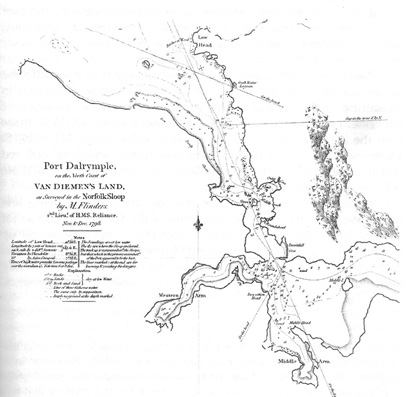Adequacy
It is tempting to apply modern terms like ‘sustainability’ to Indigenous practice however the key to understanding First People’s attachment to country is adequacy.
First Peoples did not expend energy on wasted accumulation but on a vast Estate that provided the needs of a robust population using minimal exertion. “It depended on preferring to reduce rather than increase material wants.” [Gammage Plain Facts 252]
This is why terms like ‘farming’ with its association with considerable exertion does not do justice to Indigenous practice.
Landscape management was a primary First People’s preoccupation but not a consuming one, leaving considerable time for ceremony, cultural gatherings, leisure and even beautification with men absorbed by ochre application to their hair or the mix of ochre and fat to insulate their bodies.

Even the simplified tool kit of Tasmania’s First People’s is misunderstood as primitive, even a degenerate descent into extinction. However, it was adequate; it served the purpose of their needs. What more do you need? That does not mean they were unaware of technological advantage and adopted dogs, for instance as weapons to ease capture of game. [James Boyce Van Diemen’s Land] There was a practiced eye for ease and advantage.
Again, the suggested absence of fish from the diet of First Peoples – a highly contested accusation – may be entirely due to ‘adequacy’, not taboos of consumption. Fishing, other than by way of tidal fish traps – for which there is evidence – is labour intensive whereas shellfish, cray, abalone and game are rich protein sources readily accessible.
A cold maritime climate favours consumption of calorie concentrated protein rich foods, like seafood and game, over less calorically intensive carbohydrates like grains which are endurance foods.
What made the Launceston wetland appealing was the ease of access to such rich resources. White commentary quickly seized the ease of capturing fledgling swans (without adequate flight feathers) and would row beside them and pluck them from the water in considerable numbers.
“Four unfledged black swans were caught up by the boat and brought on board in the evening afforded us great joy.” [CC Macknight, Low Head to Launceston: The earliest reports of Port Dalrymple and the Tamar River, (Flinders Journal 1798) p18.]
Again, it is maximising gain by minimising exertion. Simple adequacy, for white or black. It also meant that the timing of such abundance coincided with ceremony attracting from 3-600 people, substantial gatherings and opportunity for exchange, and marriage.
John Ross captures the ease which animated the First Peoples. The gait and manner of people “who had little to do, with their pleasure only to seek their freedom. Their air of independence was quite charming.”
Read More Understanding how First People’s viewed their world
An Encyclopedia of Tasmanian Aboriginal Anthropology
On the 18th February 1802 the Botanist, Leschenault, of the French exploration expedition led by Nicholas Baudin while at Maria Island, came across a small mound with a tent like “wigwam” of bark over it.
An Encounter with the First People of Northern Van Diemen’s Land
Dutch, French, and British explorers set foot in Van Diemen’s Land from 1642 bringing with them a range of preconceptions and prejudices about what and who they might find.
FOOD FORAGING (PART 2 “FORAGING & FOOD PREPARATION”)
Hunting by men was often one of a fortuitous meeting a quarry and resulted in a lack of success having to return to camp empty handed, but not to worry, the ever-reliable women filled the void with smaller fauna, possum and edible flora.
FOOD FORAGING (PART 1 FOOD RESOURCES 2,000 > BP)
The Tasmanian Aborigines occupied their island home for at least 40,000 years but it is only the last 2,000 years that is considered here and only mainland Tasmania and offshore islands.
An Encounter with the First People of Northern Van Diemen’s Land A Particularistic Mindset
When Lieutenant-Colonel William Paterson brought a group of white settlers – soldiers, convicts, and farmers – to Port Dalrymple, Van Diemen’s Land, the English were in a mindset of domination or mastery over other races.
Britain was the world’s naval power, the coming industrial power, the greatest empire builders and affectionately described amongst themselves as the chosen people and the Protestant Protectors.
Tamar Valley Geology Determining the First Peoples Occupation of Northern Van Diemen’s Land
When William Collins sailed down the waterway now known as the Tamar, but which he called the Main Head in January 1804, he eventually reached and entered an Arm to the East, the North Esk, and wrote in his logbook1 that “the water is perfectly fresh and good”, it flowed over a flood plain and “the Soil on its banks is very good and there is a great extent of it.”
An Encounter with the First People of Northern Van Diemen’s Land
When William Collins sailed down the waterway now known as the Tamar, in January 1804, he eventually reached and entered a river to the East, the North Esk, and wrote in his logbook.
A “grounded” rather than “portable” faith – A Psychic Invasion.
Europeans have always had difficulty in grasping a concept of religion in Indigenous practice and even denied until the mid 20th century that you could apply the term ‘religion’ to Aboriginal practice – magic and sorcery but not ‘religion’.
Tamar Valley Geology determining occupation
When William Collins sailed down the waterway now known as the Tamar, in January 1804, he eventually reached and entered a river to the East, the North Esk, and wrote in his logbook.
